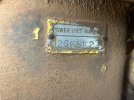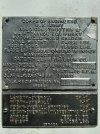A GM 6-71 is an inline 6 - a GM 6V-53 is a V6. Every 53 series GM Diesel, regardless of the number of cylinders, was a "V" design engine.
Are you sure on that grader S/No? The 9K series Cat 12 was built in the U.S. between 1938 and 1945. AFAIK, there were no 9K Cat 12E graders shipped to Australia.
The reason for this, is twofold. In 1936, with the Japs having invaded Manchuria and making threatening noises towards the U.S. and its S.E. Asian allies, the U.S. Govt slapped an embargo on the export of U.S.-built motor graders to the S.E. Asian region. This area included Australia.
The reason for the embargo was some forward-thinking people in the U.S. Govt and the U.S. Military could see that motor graders would be a huge strategic asset to an enemy starting a War in the region in the near future (here's looking at you, Japan!).
So the aim of the embargo was to ensure that a heap of very useful motor graders, for constructing airfields and roads, could not fall into enemy hands, in the case of a War.
This decision caused a great deal of anxiety in Australia, as Australian councils were crying out for new motor graders, as well as contractors and other major Govt authorities such as Public Works Depts.
There was a general belief that a whole heap of graders in Australia wouldn't be likely to fall into Japanese hands, in the event of a War - and having new graders here was going to become important in the near future.
So Waugh & Josephson, the N.S.W. Caterpillar dealer, sent a deputation to Caterpillar, asking if they could build Cat graders in Australia under licence. W&J had a huge manufacturing facility capable of making all the components of a Cat 12 - except for the engine and transmission.
Caterpillar finally agreed to the deal, obviously seeing some advantages for them in it. So ... from 1936 to 1945, W&J built Cat graders. They built all of the grader, apart from the transmission and engine - and Cat shipped in new engines and transmissions to be fitted to the W&J Cat graders.
But the graders were not called Cat Auto Patrols (as the U.S. built graders were) - they were officially called the W&J Motor Patrol (or sometimes "Speed Patrol") grader, to distinguish them from the "genuine" Cat graders. But everyone "knew" they were simply Cat graders built in Australia.
The Serial Numbers allocated to the early W&J Motor Patrol graders were the Serial Numbers of the engines supplied - which are listed in the Cat S/No records as "Industrial Engines" starting with a S/No prefix of 2S5501, and listed as "Misc Engines".
When the new Cat 12 grader was released in late 1937, W&J soon got all the blueprints for that new grader, and started building W&J Cat 12's. W&J actually built an entire new and larger factory in 1940, especially aimed at increased Cat grader production.
W&J eventually built about 600 Cat graders (with 500 produced during the War), up until 1946 - when the "licence to build" was taken away from W&J, and given to Steelweld P/L. The Steelweld graders had a Cat S/No that started with "S" and were known as Steelweld Cat graders.
When WW2 kicked off for us in Sept 1939, the Australian Govt insisted that nearly all of the W&J Cat grader production be reserved for the Military. So W&J started supplying their Cat graders to the Australian Military Forces, as well as the councils. But many councils had to give up their Cat graders for military works - these machines were "impressed" into military projects.
A number of major arterial roads within Australia were upgraded from 1940 to 1943, using a lot of the W&J Cat graders, which had been allocated to the civilian work forces tasked with the road upgrades.
Two of the major arterial roads upgraded were the Barkly Highway and the Stuart Highway. The Stuart Highway was only called the "North-South Military Road" during WW2.
The civilian workforces used to build these major military roads were -
Department of the Interior
The Allied Works Council
The S.A. Highways Dept
The N.S.W. Dept of Main Roads
The Qld Main Roads Commission
The Country Road Boards organisation.
After America entered the War on Dec 7, 1941, and American ships and supplies started to turn up here in our Southern ports (Adelaide, Melbourne and Sydney), a U.S. Army Engineer Battalion joined forces with the above groups to build many more airfields and roads. The Civil Construction Corps and the Civil Alien Corps provided a lot of the labour for many military projects.
Around 300 new airfields were built in Australia during WW2, with the Americans constructing the largest number of them, and the biggest and most strategic ones.
The Americans brought some construction equipment with them in early 1942 - D7's, D8's, Cat graders, and Carryalls - but they also relied on W&J supplying the vast majority of the Cat motor graders they used.
W&J Cat graders were also supplied to U.S. troops operating in the Islands chain to the NE and N of Australia - because it was deemed that due to a shortage of shipping from the U.S., and the risk of seaborne loss by U-boats - and delays caused by shipping times - that the U.S. forces would be far better served, acquiring as much equipment from Australia, as could be supplied.
Accordingly, the vast majority of the Cat graders used in Australia and the nearby Islands, during 1936 to 1946 were Australian-built W&J graders. AFAIK (and I stand to be corrected), no 9K S/No Cat 12 graders were ever built by W&J.
There is a possibility that the Americans left behind in Australia, at the Wars end, some number of Cat 12 9K graders that they had brought with them, in initial military cargo shipments (1942-1943).
These graders would have possibly been sold to the Australian Govt in the post-War, War Surplus settlement, that not only covered surplus Lend Lease equipment - but it also covered equipment that belonged to the U.S. forces, and which they had simply left behind, due to a lack of shipping after the War.
Virtually all of the engine-driven major U.S. military equipment items left here in Australia from the War, carry a "USN 7" stamp on or near the machine S/No.
These stamped letters/number indicates the item of equipment was the property of the U.S. Seventh Fleet, which owned a vast number of construction equipment items.
The U.S. Seventh Fleet was based in Brisbane, it was formed on 15th March 1943, and the Fleet was under the overall control of Gen Douglas MacArthur.




